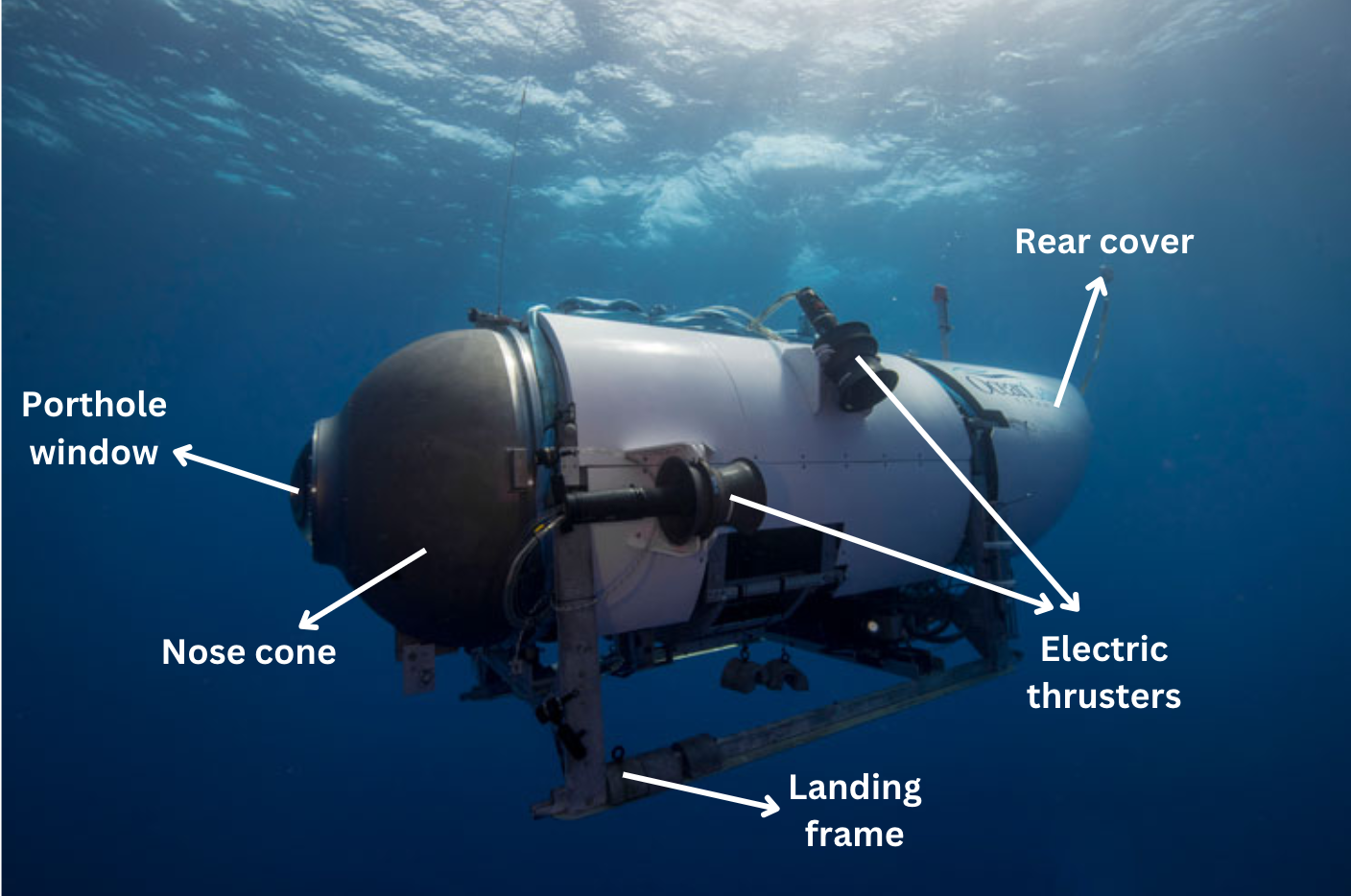The ocean is inhospitable and vast—despite rapid technological advances, a bulk of it remains inaccessible to us.
A five-day search for the missing Titan submersible came to an end in the early hours of Friday (Singapore time), after the debris field of the sub was discovered.
The vessel had suffered a “catastrophic implosion”, leaving no survivors.
Titan Submersible Imploded
The submersible was on its way to the Titanic wreckage site, nearly 13,000 feet under the sea.
Around one hour and 45 minutes into its journey, however, staff on the surface ship lost contact with the Titan.
The sub was reported missing only later that evening (18 June), kicking off a five-day multinational search effort to locate the vessel and its five passengers.
However, in a statement to the media early this morning (23 June), the US Coast Guard revealed that the Titan submersible had suffered a “catastrophic implosion”, and everyone on board is presumed dead.
In a press conference held at 3 am SGT, US Coast Guard Rear Admiral John Mauger told the press that the debris field found at the sea floor was “consistent with a catastrophic implosion” of the submersible.
According to expert Carl Hatsfield, it is believed that the vessel had imploded in the water column above the wreckage site in its descent. The debris field of the Titan was found approximately 488 metres away from the bow of the Titanic, 4,000 metres under the sea.
It is therefore unlikely that the vessel collided with the Titanic’s wreckage.
“To my knowledge, there’s no Titanic wreckage in that area,” he said, adding that an implosion in the water column would be “consistent with the location of last communication”.
What Exactly Was Found?
A tweet from the US Coast Guard at 11.48pm SGT last night disclosed that a remotely operated underwater vehicle (ROV) found a debris field within the search area.
At that time, it was unclear if the debris field belonged to the Titan.
“Experts within the unified command are evaluating the information,” they wrote, informing the public that a press conference would be held to discuss the findings.
It was revealed later that the discovery of five major pieces of debris allowed for the identification of the Titan.
First, here’s a diagram in case you’re confused which part is which:

The pressure hull is the inner hull of a submersible that provides passengers with a pressure-resistant environment and maintains structural integrity.
The light hull is the outer hull of the submersible, so it’s what we usually see.
The first discovery was the nose cone, which led searchers to a larger debris field.
The larger debris field contained the front end bell of the pressure hull. According to undersea expert Paul Hanken, that discovery was the “first indication that there was a catastrophic event”.
They later found a smaller debris field that contained the other end of the pressure hull, which meant they had essentially discovered the entire pressure vessel.
What’s An Implosion?
An implosion and explosion are different—as the prefix suggests, an implosion involves an inward collapse.
In an explosion, pressure pushes outward in a contained space, and the material explodes when it can no longer withstand the pressure.
When the Titan imploded, the submersible collapsed on itself due to the immense pressure exerted by the ocean pushing inward.
If the hull had been defective, it’s possible that the process might have happened in just milliseconds, leading to an almost instantaneous death.
Without the protection of a submersible, humans cannot survive at the depth of the Titanic’s wreckage site, located around 3,800 metres under the sea.
There, the pressure is nearly 400 times that of atmospheric pressure, making survival virtually impossible.
According to engineering professor Roderick Smith, it is possible the submersible imploded due to a failure of the pressure hull.
He cautioned that the precise sequence of events would be difficult to determine, due to the violence of the implosion.
The depth of the ocean renders the recovery of the bodies incredibly difficult.
Navy Detected Sounds Of Possible Implosion
After the Titan submersible was reported missing on Sunday night, the U.S. Navy analysed acoustic data gathered by its secret acoustic monitoring system used to detect submarines.
Speaking anonymously to Wall Street Journal, a Navy official revealed that an “acoustic anomaly” was detected in the general area where the Titan submersible went missing (where communications were lost).
The sound was also consistent with an implosion or an explosion.
Reports of the anomaly were shared immediately with the officials leading the search, but since the sound was “not definitive”, search efforts continued.
The sounds detected by the Navy were instead used to narrow down the area of the search.
Director of the movie Titanic and deep-sea explorer James Cameron corroborated this, stating that his sources had also heard a “loud bang”.
He said that he had suspected the Titan had imploded from the start, when his sources had allegedly heard a “loud bang on the hydrophone”.
Sonobuoys deployed by rescuers did not pick up the sound of an implosion.
Earlier in the search, it was reported that “banging noises” were picked up by these sonobuoys. However, Rear Admiral Mauger said that there did not seem to be a connection between these noises and the Titan’s location on the sea floor.
The noises could have come from underwater marine life, or by other vessels in the vicinity. It was initially suspected that the banging noises might have come from the Titan, since submersible crew are taught to bang on the hull if they are unable to communicate with the surface.
Since sound travels well in water, the banging noises can be picked up by sonar.
Doomed To Fail?
A gruelling, five-day long search has finally come to a grim conclusion, but this might not be the end for the company responsible for the submersible, OceanGate Expeditions, as they come under fire for safety concerns.
CEO Stockton Rush, one of the five crew members in the submersible, admitted to “breaking rules” in constructing the submersible.
While giving a tour of the vessel to Mexican actor Alan Estrada, Rush spoke about the eighteen-centimetre thick acrylic window, designed to allow passengers to view the Titanic’s wreckage.
Admitting in the clip that he had “broken some rules” to make the submersible, he said that the window gets “squeezed in” by water pressure as the sub descends.
He spoke his now-(in)famous line in the video too: “If you just want to be safe, don’t get out of bed.”
Since the submersible went missing, its safety has come under scrutiny.
These concerns date back to 2018, where experts, including a former OceanGate employee, raised concerns about the Titan’s safety.
That year, former employee David Lochridge and Oceangate filed lawsuits against each other.
Lochridge pointed out safety issues stemming from the design of the hull and its ability to withstand the crushing pressure of the ocean.
After discussions, Lochridge found OceanGate’s design decisions unacceptable, and refused to authorise a manned journey without further testing. OceanGate then fired him.
The Marine Technology Society’s (MTS) chairman raised similar safety concerns, since OceanGate had neglected to follow standard industry protocol in designing and testing the submersible.
The Titan submersible was also not certified under the DNV-GL, a certification issued by Norwegian foundation Det Norske Veritas widely seen as the gold standard for marine equipment like it.
The sub was only certified to withstand pressure at a depth of 1,300 metres, though it was claimed the Titan was able to descend to a depth of 4,000 metres.
OceanGate might not be safe from lawsuits either, despite the liability waiver that passengers had to sign to board the vessel.
A report by Reuters states that these waivers are “not always ironclad”, and judges can shoot them down if evidence of gross negligence is found.
It is also possible all aspects of the vessel’s design were not fully disclosed to passengers, or the submersible was operated with the knowledge that it was not suitable to undertake the expedition.
So, families of the deceased might be able to file a lawsuit against OceanGate, though it is currently unclear if OceanGate is able to pay significant damages.
OceanGate might also be able to shield itself from paying any damages by requesting that courts limit damages to the present value of the vessel.
Because the Titan is completely destroyed, that value amounts to zero.
If OceanGate chooses this path, the company will be required to prove that it did not know of possible defects of the Titan at all.



